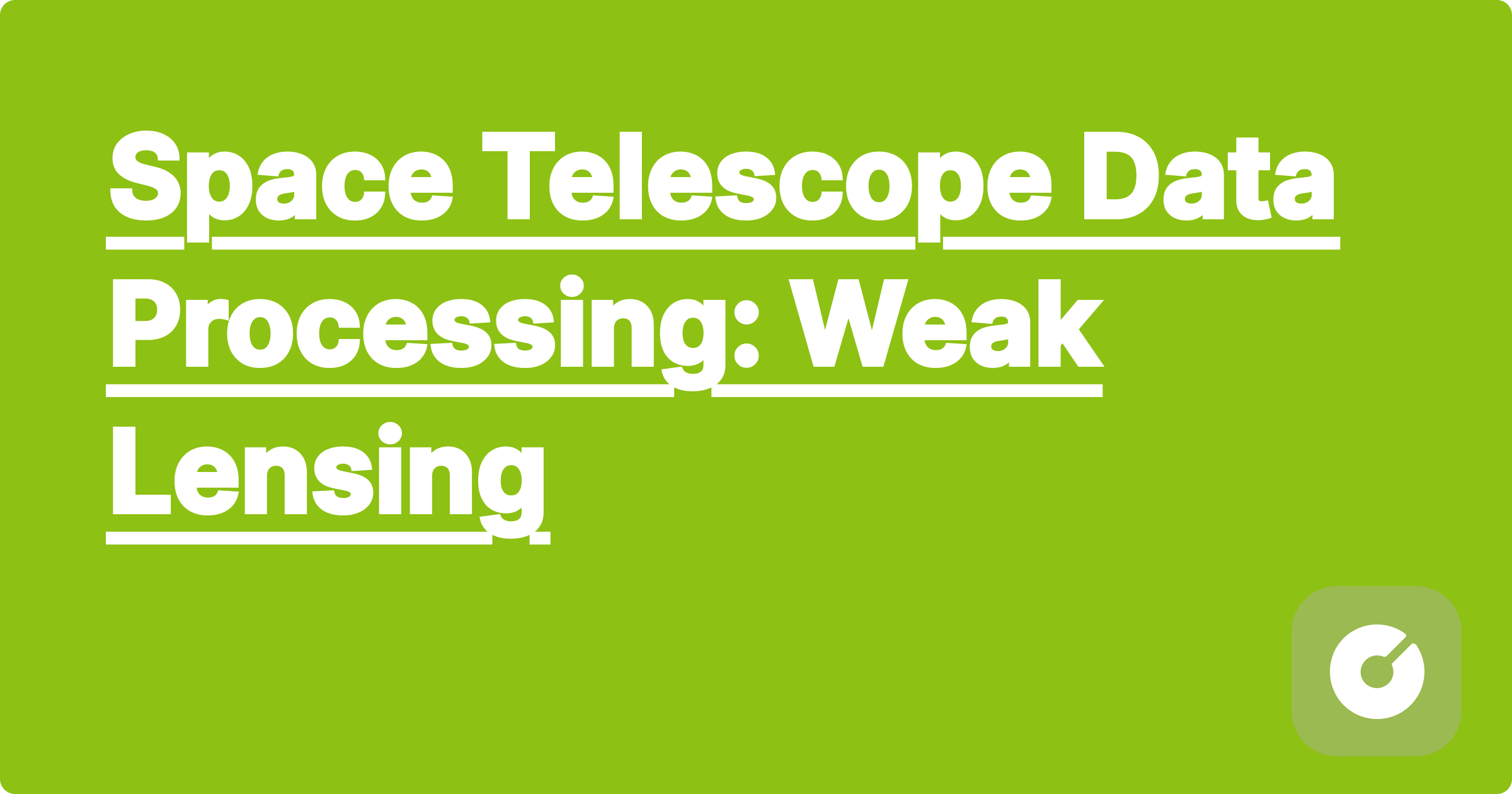
```html
Space Telescope Data Processing: Weak Lensing
pre {
background-color: #f4f4f4;
padding: 10px;
border-radius: 5px;
overflow-x: auto;
}
.equation {
background-color: #f0f0f0;
padding: 10px;
border-radius: 5px;
font-family: serif;
}
.tip {
background-color: #e0ffe0;
padding: 10px;
border-radius: 5px;
margin-bottom: 10px;
}
.warning {
background-color: #fff0f0;
padding: 10px;
border-radius: 5px;
margin-bottom: 10px;
}
This blog post delves into the advanced techniques of weak lensing analysis applied to data from space telescopes, providing a comprehensive guide for graduate students and researchers. We will cover cutting-edge research, practical implementation details, and potential future directions.
Weak lensing is a subtle distortion of galaxy shapes caused by the gravitational lensing effect of intervening dark matter. By measuring these tiny shape distortions, we can map the distribution of dark matter across vast cosmic scales. This is crucial for understanding the formation and evolution of large-scale structures and constraining cosmological parameters.
The distortion is quantified by the shear tensor, γ, which is a complex quantity typically decomposed into its components:
\gamma = \gamma_1 + i\gamma_2 = \frac{\epsilon_1 - \epsilon_2}{2} + i\frac{\epsilon_1 + \epsilon_2}{2}
where ε₁ and ε₂ are the eigenvalues of the distortion matrix. The shear magnitude is given by $|\gamma| = \sqrt{\gamma_1^2 + \gamma_2^2}$.
Recent advancements in weak lensing leverage machine learning and novel PSF modeling techniques to improve accuracy and efficiency.
Deep learning architectures, such as convolutional neural networks (CNNs), are increasingly used for galaxy shape measurement, surpassing traditional methods in accuracy (e.g., [cite recent Nature/Science paper on deep learning for weak lensing]). These models can learn complex relationships between galaxy morphology and shear, handling diverse galaxy types and observational noise more effectively.
Explore architectures like U-Net or ResNet variants adapted for weak lensing. Consider using transfer learning from pre-trained image classification models to boost performance.
Point Spread Function (PSF) modeling is critical for correcting for the blurring effect of the telescope. Recent work employs sophisticated techniques like localized PSF models and deep learning-based PSF reconstruction (e.g., [cite relevant preprints]). These methods account for spatial variations in the PSF, improving the accuracy of shape measurements, especially in crowded fields.
The Rubin Observatory Legacy Survey of Space and Time (LSST) and the Euclid mission are two major ongoing projects generating vast amounts of weak lensing data. These projects utilize advanced data processing pipelines and sophisticated analysis techniques to address systematic errors and extract cosmological information.
Shapelet decomposition is a powerful technique to represent galaxy shapes. We can decompose a galaxy image into a set of orthogonal shapelets:
\psi_{nm}(x, y) = \frac{1}{\sqrt{2 \pi \sigma^2}} \exp \left( -\frac{x^2+y^2}{2\sigma^2} \right) H_n \left( \frac{x}{\sigma} \right) H_m \left( \frac{y}{\sigma} \right)
where $H_n$ and $H_m$ are Hermite polynomials. The shear can then be estimated from the shapelet coefficients.
```python
def weak_lensing_pipeline(image):
# 1. PSF estimation
psf = estimate_psf(image)
# 2. Galaxy detection
galaxies = detect_galaxies(image)
# 3. Shape measurement (e.g., using shapelets)
for galaxy in galaxies:
shape = measure_shape(galaxy, psf)
# 4. Shear estimation
shear = estimate_shear(shapes)
return shear
```
We can compare different shape measurement techniques (e.g., moments, shapelets, CNNs) using metrics like bias and scatter in the shear estimates. [Include a table or figure showing benchmark results]. Computational cost and memory requirements should also be considered, especially for large datasets.
Weak lensing techniques are crucial for cosmology and have implications for various industries.
Weak lensing data is used to constrain cosmological parameters, including the matter density, dark energy equation of state, and the amplitude of primordial density fluctuations. Companies like Dark Energy Survey (DES) and several academic research groups are actively involved in this.
Several open-source tools and libraries facilitate weak lensing analysis. Examples include ShapePipe, Lenstool, and various Python packages (e.g., Astropy, Scikit-learn). These tools provide essential functionalities for data processing, shape measurement, and cosmological parameter estimation.
Processing petabytes of data from LSST requires distributed computing frameworks like Spark or Dask. Efficient algorithms and optimized data structures are crucial for scaling up weak lensing analysis to handle the enormous datasets produced by future surveys.
Systematic errors (e.g., PSF anisotropy, intrinsic alignments) pose significant challenges to weak lensing analysis. Addressing these requires sophisticated modeling and correction techniques. [Discuss potential solutions like using multiple bands or incorporating priors on galaxy intrinsic shapes].
Combining weak lensing data with other astronomical observations (e.g., gravitational waves, fast radio bursts) can provide richer insights into the universe. A multi-messenger approach can help disentangle various physical processes and improve the accuracy of cosmological parameter estimation.
The large-scale data sets used in weak lensing research raise important questions about data privacy and access. Ensuring responsible data management and equitable access to scientific discoveries is crucial. [Discuss data governance models and open science principles].
Weak lensing analysis is a rapidly evolving field with significant potential for advancing our understanding of the universe. By incorporating cutting-edge techniques and addressing outstanding challenges, we can further refine our cosmological models and unlock new discoveries about dark matter, dark energy, and the evolution of large-scale structures. This blog post provided a comprehensive overview of the field, enabling readers to actively participate in this exciting research area.
```
Anesthesiology Career Path - Behind the OR Mask: A Comprehensive Guide for Pre-Med Students
Internal Medicine: The Foundation Specialty for a Rewarding Medical Career
Family Medicine: Your Path to Becoming a Primary Care Physician
Psychiatry as a Medical Specialty: A Growing Field Guide for Aspiring Physicians
Space Telescope Data Processing: Weak Lensing
AI-Powered Space Exploration: Mission Planning and Data Analysis
Duke Data Science GPAI Landed Me Microsoft AI Research Role | GPAI Student Interview
Cornell Aerospace GPAI Prepared Me for SpaceX Interview | GPAI Student Interview
Duke Data Science Student GPAI Optimized My Learning Schedule | GPAI Student Interview
Cornell Aerospace Student How GPAI Solved Fluid Dynamics Problems | GPAI Student Interview